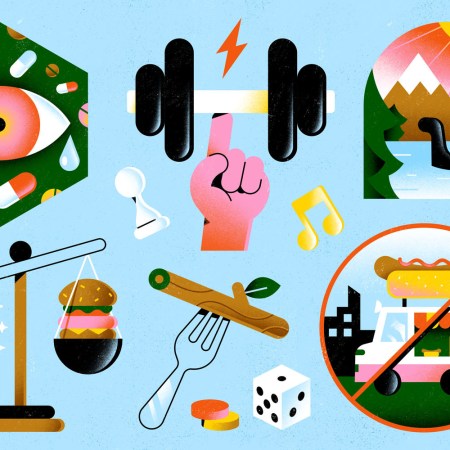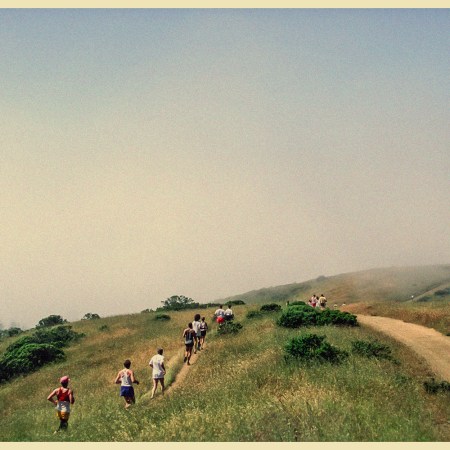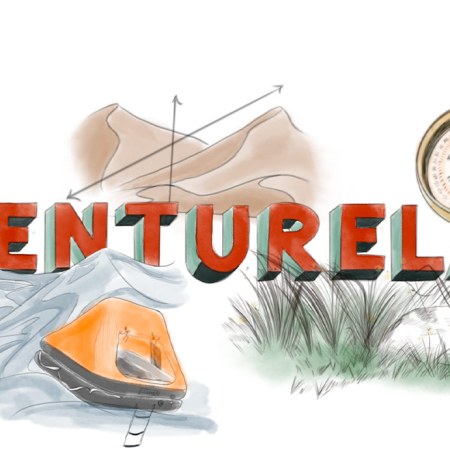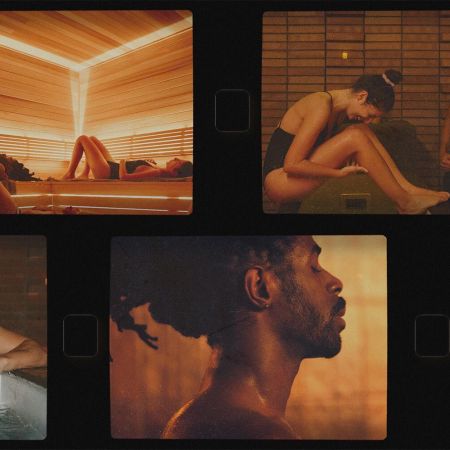Can the “Flow State” Save Us From Distraction?
Coined by psychologist Mihaly Csikszentmihalyi, flow offers rare clarity. We asked athletes, chefs and musicians how they find it again and again — and how you can, too.

I learned a new phrase the other day: “digital dementia.” It’s not an actual health condition — not yet, at least — but a term to describe a creeping, recognizable phenomenon. We are becoming a scatterbrained people. All of us. Even our kids. We’re reading emails while people we love are trying to tell us stories. We’re online shopping while our supposed favorite shows are on. We’re opening an app and closing it and opening the exact same one a millisecond later.
No task is safe from the pinching mental reminder that we could be attending to another one. Few in-person human interactions are holy against the infinite digital ones we could be having at any second of the day. We’ve locked ourselves in the arcade, playing whack-a-mole with our own lives. We’re dreadfully unhappy, we’re getting dumber all the time, and most days, we’re too numbed out to care.
Our attention spans are quantifiably shorter. Not shorter than goldfish — that’s a myth, mercifully — but, still, short: 47 seconds is now the average. Those precious seconds are worth billions to politicians, influencers, marketers and Big Tech. The powers that be have never thought less of you and never wanted more from you.
Over time, yeah, we’ve wised up to this: mental-health advocates and productivity experts — who, oddly, often sound similar societal alarms — are meeting in the middle of an unlikely Venn diagram, around the idea of presence. They want us to embrace boredom, tap into deep work, remember that one day we will die. Their alliance is predicated on the understanding that we are not designed to live in a permanent state of partial attention. If we are to accomplish anything, if we are to feel that our lives have purpose and meaning, if we are to once again sink our teeth into something, we’ve gotta live a little more goddamn intentionally than this.
Never mind that the phones are addictive. Never mind you didn’t ask for this. Those facts are now as concrete, as immutable, as the reality that your life is singular — and each day is inching closer to its end. So accept it, and ask yourself: What am I going to do about it?
Two words: find flow.

The Father of Flow
Long before Mihaly Csikszentmihalyi spent four decades shaping minds at the University of Chicago, publishing more than 250 research articles along the way, he was a teenager in the 1950s trying to make sense of a Europe still reeling from the horrors of World War II.
Adults had lost everything — homes, jobs, their sense of security, leisure and hope. Csikszentmihalyi’s family had suffered their own losses, and after his father refused to support Hungary’s new Communist regime, they were stripped of their citizenship and forced to start over in Rome. His father opened a restaurant, and Csikszentmihalyi dropped out of school to help keep the family afloat.
Still, the trauma of the era gnawed at his conscience. He turned to art, religion, even rock climbing to make sense of the world and his place within it. One night, while traveling through Switzerland, he stumbled into a lecture on UFO sightings. The speaker suggested that these visions were symbols, not spacecraft — projections of a collective psyche searching for meaning in the aftermath of war. The man on stage was Carl Jung.
Inspired, confused, hungry for more, Csikszentmihalyi moved to the United States — and dedicated his life to the study of positive psychology, which might be described as the scientific exploration of what makes life worth living. The Hungarian American’s legendary work orbited questions of happiness, purpose and creativity. What are the conditions that help people thrive? What happens when our attention is fully aligned with our actions? What sort of life unfolds when effort becomes its own reward?
“Nothing Else Seems to Matter”
Csikszentmihalyi’s most enduring research concerned “flow,” or more colloquially, the flow state — being in the zone, getting in a groove. His 1990 book Flow is about the unfettered joy and untapped power of total absorption. It sold over a million copies, was translated into more than 20 languages, and resonated far beyond academia. The world was still a few years removed from the daybreak of the internet age, but already it was fraying — there were signs that attention was becoming currency, that distraction was the new default.
If Csikszentmihalyi’s work offers an official definition of flow, it is this: “A state in which people are so involved in an activity that nothing else seems to matter; the experience is so enjoyable that people will do it even at great cost, for the sheer sake of doing it.”
It’s the sort of line you start highlighting before you’ve finished reading it. I remember where I was when I read it: in a coffee shop in the East Village, sitting amongst glowing laptops and somniferous surf rock, sipping a beer before grabbing dinner with a friend. Yes, I thought. I’m a writer, obviously, and a runner, too. Immediately my mind drifted to the very best of those activities, those efforts that seemed to collapse time.
As flow became a primary activity in my life, I was eventually able to turn it into a method. No hard conjuring necessary. It’s almost on speed-dial at this point.
– Eugene Hütz, frontman of Gogol Bordello
The Flow I’ve Found
A decade ago I sat on a wild beach in western Denmark, my back against the dunes, scratching out a poem in a journal. The hour or so that I sat there was one of the most important experiences of my life. I didn’t consciously “do” or “think” a single thing; I just watched my pen write, and I knew it was over when I once again knew where I was. I blinked through my dry contacts, looked down and read a poem about 9/11.
Like many kids who grew up in or around New York City, the day had marked my childhood, it had woken me up to the world, to the crush of life. I’d written the poem upon realizing that that day was 9/11. Away from home, I’d blindly lived much of the day without realizing the date — or thinking about it at all. How far I’d come, I mused, wounded for my young self, confused about what it all meant. The thoughts were extremely uncomfortable. But synthesizing them into a poem was anything but. I showed it to a Danish author — I was on the island with a literature class, for my study abroad program — and he was the first professional who told me I had what it took to become a writer. I beamed. But even if he only nodded in ambivalence after my reading, I’d reached a conclusion: I wanted more of that…whatever it was.
Over my running life, too, I’ve been lucky enough to fall headfirst into deep, rich wells of flow. I can remember finishing my first 10-miler as a stick-figure 15-year-old — how I hadn’t intended to go that far but had forgotten I even had the option to stop. Or running dawn loops in Prospect Park while training for the marathon, enchanted by the frosty vapor and the waterfowl hovering over the pond. Or all the times I’ve logged 400-meter repeats at the track and the pain has slipped from my face.
It doesn’t happen every time. But more often than you might believe, there’s a point at which my jaw relaxes, the furrow leaves my brow, and even the music in my ears — meant to be ergogenic — fades away. All that’s left is my body moving in space, the tilt at the turns, my brain bobbing along the border of a different dimension.

Nine Component States
As freewheeling as flow feels, as mythical as it sometimes seems, the state does adhere to a qualifiable superstructure. Csikszentmihalyi spent decades studying people who regularly entered flow — from artists to surgeons and climbers to chess masters — and eventually identified nine “component states”: challenge-skills balance, action-awareness meaning, clear goals, unambiguous feedback, concentration on the task at hand, paradox of control, loss of self-consciousness, transformation of time, and autotelic experience.
That’s…a lot of words. What do they all mean?
Here’s a breakdown: In order to achieve flow, the performer must be well-matched to the activity at hand — not too expert, not too green. They should be challenged, not bored. Activated and engaged. The performer knows exactly what they’re trying to accomplish, including the many mini-steps along the way, and they have a clear sense of how they’re doing. But that’s about all they’re aware of. Time either slows to a crawl or flies by. Focus narrows to a pinpoint, shutting out would-be distractions. The performer forgets their ego (they neither consider nor care what they look like during flow), and abandons their needs (they don’t reach for snacks, or check the clock or wonder if they need a bathroom break). They simply float forward.
Once you’re in flow, it can feel bulletproof. As mental states go, it seems like a cheat code: temporary immunity to time, ego or distraction?! But reaching hyper-focus requires some entry-level focus. Unlocking flow is notoriously difficult; it demands a blend of creativity and curiosity, patience and practice. And the edge of flow is a tightrope. A phone notification, a self-conscious thought, one tiny shift in rhythm — they can all break your stride before you fully drop in.
Way easier said than done, in this age of constant context-switching. (Confession: I have checked my notifications nonstop while writing today. I can confidently say I am not in flow.) Thirty-five years since Csikszentmihalyi published his research, flow is more fringe than ever, separated from our bumblebee lives by a pea soup fog. So, how on earth do we unlock it?
The Flow Pros
For the last few months, I’ve reached out to a variety of artists and athletes who have no choice but to find flow at regular intervals. Their livelihoods depend on it, but sometimes so do their lives, full stop; the activity is at the core of their being. In typical Csikszentmihalyi fashion, the action is the reward.
“It’s heaven,” Josh Niland wrote to me, when I asked him to describe the flow state. The Australian chef’s Sydney restaurant Saint Peter was named to The World’s 50 Best Restaurants in 2024. Niland’s published three cookbooks, and been called a “seafood revolutionary.”
“It’s this complete out-of-body experience where you can nearly see yourself from six feet above,” he said. “Anticipatory awareness is sharp. Usually my mind goes completely quiet and I’m able to hear guests on the other side of the room talking or hear lyrics of the music in the dining room.”
Could dinner service possibly be as notorious as the Canadian Rockies? Either way, the antidote’s still flow. Cody Townsend, a professional skier, Salomon athlete and adventurer behind The Fifty, described flow as “being able to dodge a spray of bullets coming at you without a nick.” And Christina “Lusti” Lustenberger, a former Olympian and elite ski mountaineer for the North Face, who has conquered first descents all across the world, called flow a “a space where fear and courage coexist.”
“Fear sharpens your instincts,” she said. “The mountains I play in do exactly that. There’s no room to escape the moment — you’re simply there, fully present.”
In a 1996 interview with Wired, Csikszentmihalyi said of flow: “Every action, movement, and thought follows inevitably from the previous one, like playing jazz.” I turned to David Ying, an associate professor of string chamber music at the Eastman School of Music at the University of Rochester, for some introspection on the self-evident link between flow and musical improvisation.
“For me, the flow state makes time stop,” he said. “Each moment feels full and immediate and seamlessly connects to the next. Playing the cello is really consuming, especially when I’m performing. It requires such physical skill, mental focus and emotional involvement…but honestly, I don’t feel fatigue or physical discomfort when I’m fully present in my cello playing. It all disappears.”

Flow Is a Precious Commodity
Eugene Hütz, the frontman for Gypsy punk band Gogol Bordello, whose new compilation just dropped, has a personal relationship with Flow. He read the book when it was originally published, and remembered receiving its teachings as confirmation that he was on the right track. As a kid, flow had sometimes come upon him like an “avalanche.” He’d leave high school classes to go play the drums, or set out on “Byronic walkabouts” to work on his poetry. “[These things] seemed of the essence,” he said. “So I let everything dissolve into the background.”
As Hütz grew into adulthood and his music career took off, he began to consider flow “a precious thing…which needed to be handled with care.”
In other words: flow was a commodity, which could run dry without discipline. He chose to cherish it, to never take it for granted: “As flow became a primary activity in my life, I was eventually able to turn it into a method. No hard conjuring necessary. It’s almost on speed-dial at this point.”
Descriptions vary, but this is a common refrain amongst the artists and athletes who regularly enter flow. It’s hard to say they’re “finding flow” or “unlocking” it — either image suggests someone reaching out in the dark, fumbling with their keys. When you hone your attentional faculty day after day, year after year, flow is no yeti. It’s your next-door neighbor. Ying said as much: “I think that I expect to get to flow now. It’s not a rare or mysterious thing. For me, it’s the result of good preparation and willful focus.”
Flow is being able to dodge a spray of bullets coming at you without a nick.
– Cody Townsend, professional skier
It’s not easy to get there. Consider Alvaro Nuñez, a Spanish entrepreneur who was featured in Sports Illustrated after running seven marathons in seven days…on all seven continents. He’s also biked the Florida500, flies helicopters and owns a skydiving company. Call him a vitalist. Nuñez routinely strong-arms his way into flow, relying on a combination of experience and mental engineering. “Flow isn’t random — it’s a skill,” he said. “By repeatedly putting myself in high-pressure situations, I’ve learned to access it on demand.”
More specifically, Nuñez “creates the conditions.” He sets a purpose, visualizes success, reaches for environments of controlled chaos…and then lets go: “Once the moment arrives, I surrender. Flow isn’t about control — it’s about trusting preparation and instincts to take over.” Annie Haeger, a strategist for the Canadian NorthStar SailGP Team, echoes this sentiment. “It’s about letting my body do the work,” she said. “If you’ve put the hard work in before the task is upon you, it’s easier to actively calm your nerves and feel loose.”
In speaking to various professionals, it struck me, as a willful lone wolf (writing, running), how tricky — yet ultimately rewarding — it must be to cultivate flow with a group. The success of Niland’s kitchen, he explained, is riding on his ability to limit “social distractions from team management, negative energy from people around me or severe sleep and food deprivation.”
So long as he’s established clear communication with his team both at the front and back of the house, and telegraphed a calm sense of control, his staff can do what they’re trained to do: “Control the service at your speed, don’t let the service control you.” Of course, there’s a whole lot of adrenaline in that sort of nightly performance. But flow can outlast the adrenaline. “It can be managed over far longer periods,” Niland said, “if the conditions are optimal.”
How About You?
Aside from their command of flow, the artists and athletes I spoke with have something else in common: they all do cool shit. They’re inspiring, yes, but almost to the point of being intimidating. Is creating art — on canvas, or in motion — a proviso for finding flow, for keeping it close by? What if I’m just a normal person, locked into a normal 9-5, who feels excluded from this discussion entirely?
Don’t despair! Csikszentmihalyi contended that flow is available to anyone doing something difficult, structured and meaningful — so long as your attention is fully aligned with the task. To start, you’ll want to perform a self-audit and identify the activity that falls in your wheelhouse. Read the nine component states again. There must be something that comes to mind, something absorbing and challenging (but not too challenging), which has a clear goal that you’re confident you can attain. Need ideas?
Swimming laps. Reading dense books. Fixing bikes. Learning new chord progressions. Cooking stir-fries from scratch. Running trails. Throwing pottery. Solving puzzles. Painting rooms. Practicing free throws. Cultivating a garden. Sanding furniture. Editing videos. Journaling with focus and structure. Playing chess. Writing code. Reorganizing a space with intention. Sketching a still life. Sewing a garment start to finish.
Note well: I’m not saying you have to be an expert in any of these pursuits. Flow is relative. It’s less about how talented you are, and more about how appropriate the challenge is. For instance, I weirdly tap into flow while playing pickleball — not because I’m some master at it, but because I usually plays friends and family who are just good enough to push me. Sweet-spot friction is where the magic happens.
How about work work? Yes, flow can be found in your 9-5 — it’s possible. Or at least in a portion of it, like the few hours you can reserve for what’s often called “deep work.” That’s the time when you’re not checking emails or sitting in meetings. You’re at your proverbial (or literal) pen and pad, working through your job’s big questions. Georgetown University professor Cal Newport has championed the approach as a way to push back against the self-defeating nature of what he calls “the hyperactive hive mind.”
In order to find true flow at work, though, the work has to matter to you. It has to feel meaningful, rooted in growth. You have to believe in it. And ideally, you’re already good at it — or at the very least, eager to get better. Whatever the task, there should be a clear sense of progression, and a sense that you’re fully present while doing it.
If that description sounds like a universe away from your day’s work…then it probably isn’t fertile terrain for flow. But that isn’t that surprising, anyway. So many of us now report to workdays that unravel in an infinite string of pings. It’s entirely possible — common, even — to be a workaholic, completely tethered to your job, and never once enter flow. Because that kind of work isn’t about absorption. It’s about availability. You’re not aligned with anything. You’re just online.
This sort of work may resemble flow, the way scrolling endlessly on social media, or tab-hopping for a new pair of sneakers can feel like a time-bending, out-of-body experience. But Csikszentmihalyi called this “junk flow.” It’s a counterfeit version of flow, which lacks depth, purpose or long-term fulfillment. You feel a compulsion to surf TikTok, not a calling in your bones. It’s a slot machine, not a path forward.
In the End, What’s Worth Doing?
We live in an age where our attention is being “auctioned off to advertisers.” Your time is literally precious. And if you’re able to spend some of it in flow — truly in it — what does that make flow? I thought a lot about this, and settled on one word: sacred. If you can access flow in the 2020s, it’s a sacred experience. You should defend it with everything you’ve got.
No wonder Hütz likened flow to “a portal into your higher self, as they call it in the scriptures.” Or that Niland called it “heaven.” Or that Townsend described it as a “superhuman experience.”
“Your mind speaks in full-length conversations to yourself in tenths of a second,” Townsend said. “Observations are both vast yet detailed. It feels as if you have 360 degrees of sight but with the focus and detail of a microscope. Every sense within you is heightened to an almost superhuman ability. It no longer feels like the person you’ve known your entire life is driving the car anymore. You’d call it out-of-body experience, yet you’re deeper inside yourself than you’ve ever been. It’s tapping into a level of consciousness that you never knew existed.”
Consciousness without self-consciousness. Alignment with the universe. It isn’t woo-woo. It’s the life, autotelic. That phrase is derived from two Greek words: “auto” (self) and “telos” (end or purpose). When we do things worth doing, for their very sake, and for no expected reward, the world unfurls.
I don’t want to live a distracted life. I have good days and bad days, but that elemental plea never leaves my gut: please don’t burn through attention like cheap gasoline. Not today! Please reintroduce me to clarity, meaning and joy. I guess it would be helpful if I could offer some sort of distilled, one-size-fits-all cheatsheet here — a guide to beating the algorithms and looking existence in the eye again. But I don’t think it works like that. I think you have to figure this out on your own.
All I know is that when you do something worthwhile, because you want to, because you think you should, and you stick to it, the world takes notice. It puts you in a queue to be struck by a thunderbolt. And that zap is so sharp, so indelible, that it wakes you up for good. You start walking around, blinking to adjust to the colors, and all you can think is: my goodness, where on earth have I been all this time?
The Charge will help you move better, think clearer and stay in the game longer. Subscribe to our wellness newsletter today.




